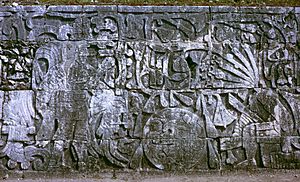Human sacrifice in Maya culture facts for kids

During the pre-Columbian era, human sacrifice in Maya culture was the ritual offering of nourishment to the gods. Blood was viewed as a potent source of nourishment for the Maya deities, and the sacrifice of a living creature was a powerful blood offering. By extension, the sacrifice of human life was the ultimate offering of blood to the gods, and the most important Maya rituals culminated in human sacrifice. Generally, only high-status prisoners of war were sacrificed, with lower status captives being used for labor.
Human sacrifice among the Maya is evident from at least the Classic period (c. AD 250–900) right through to the final stages of the Spanish conquest in the 17th century. Human sacrifice is depicted in Classic Maya art, is mentioned in Classic period hieroglyphic texts and has been verified archaeologically by analysis of skeletal remains from the Classic and Postclassic (c. AD 900–1524) periods. Additionally, human sacrifice is described in a number of late Maya and early Spanish colonial texts, including the Madrid Codex, the Kʼicheʼ epic Popol Vuh, the Kʼicheʼ Título de Totonicapán, the Kʼicheʼ language Rabinal Achi, the Annals of the Kaqchikels, the Yucatec Songs of Dzitbalche and Diego de Landa's Relación de las cosas de Yucatán.
See also
 In Spanish: Sacrificios humanos en la cultura maya para niños
In Spanish: Sacrificios humanos en la cultura maya para niños

